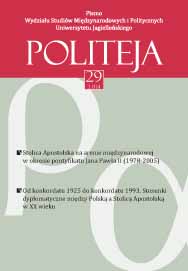Polityka wschodnia Stolicy Apostolskiej w latach 1978‑1989/ 1990: idee i warto ści w dzia łaniu
The eastern policy of the Holy See in the years 1978‑ 1989/1990: the ideas and values in action
Author(s): Maciej MrózSubject(s): Politics / Political Sciences
Published by: KSIĘGARNIA AKADEMICKA Sp. z o.o.
Keywords: papal diplomacy; papal teaching; the Holy See; international politics; Central‑Eastern Europe; John Paul II
Summary/Abstract: The history and the beginnings of Vatican diplomacy, its high prestige in the field of international relations. The text discusses the features, modes of action, the hierarchy and the number of the Vatican diplomats. The beginnings of the difficult collaboration of the Holy See with the East, inaugurated by John XXII and Paul VI, continued by John Paul II. After a Pole was chosen as the bishop of Rome there was an intensification of the Vatican’s eastern policy. John Paul II openly fought for and frequently spoke about respecting human rights and the increase of the freedom of the Church, not only in Poland, but also in the entire eastern bloc. We should mention the fact that during the events of December 1980 and the period of tension in Poland, John Paul II submitted a letter to Leonid Brezhnev expressing his concern about the fate of Europe and Poland. The bishop of Rome also established a collaboration with the Hungarian episcopate at that time. Despite initial difficulties, he also did so with Czechoslovakia. By making pilgrimages to his fatherland and by meeting general Jaruzelski, the Pope made vigorous attempts to normalize all diplomatic relations between the Vatican and Poland. This normalization eventually happened on 17 July 1989. In the second half of the 1980s Mikhail Gorbachev played a considerable role in the warming of the relations between the Vatican and Moscow due to his policy of reconstruction (perestroika). The extension of the dialogue between the Vatican and Moscow was facilitated by the visit made by the Soviet leader to the Pope in December 1989, and especially by the declaration made during that visit that there was a will to bring about a turning point in the religious policy and a will to confer an official status to the relations between the Soviet Union and the Vatican. The Polish Pope’s political sense, and especially his belief about the necessity of making a break with the post‑Yalta order in Europe and in the World, an order that was viewed as a moral catastrophe, entailed the idea that the Vatican’s eastern policy did not reach its end with the Spring of the Nations of 1989 and the demise of the Soviet Union, but that it entered a new stage of its development. The diplomacy of the Vatican in the face of democratizational processes in Eastern Europe and the emergence of a new political map drawn up on the ruins of the USSR had very little time to spare to adapt its activities to the dynamically changing reality. In the new political reality in the eastern part of the continent there came to the fore the question of restoring or establishing by the Holy See of diplomatic relations both with the countries with a Catholic majority, such as Poland, Hungary and Lithuania, or with countries which were widely represented by Catholics, countries such as Belarus or the Ukraine, or with countries in which the Catholics were a religious minority, as in the case of the Russian Federation.
Journal: Politeja - Pismo Wydziału Studiów Międzynarodowych i Politycznych Uniwersytetu Jagiellońskiego
- Issue Year: 11/2014
- Issue No: 29
- Page Range: 121-145
- Page Count: 25
- Language: Polish

